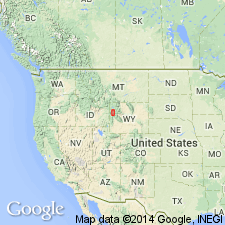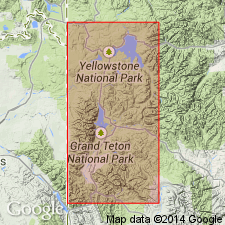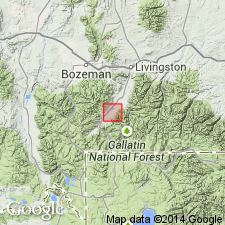
- Usage in publication:
-
- Colter formation*
- Modifications:
-
- Named
- Dominant lithology:
-
- Sandstone
- Tuff
- Conglomerate
- AAPG geologic province:
-
- Yellowstone province
Summary:
Named for Colter Bay on Jackson Lake, T45N, R115W, Teton Co, WY in Yellowstone province. Type section is in secs 20, 21, 22, 27, 28, and 29, T46N, R114W. Rocks called Colter in this report were unnamed in previous reports. Areal distribution shown an a map. Thickest (7,000 ft thick) outcrops are near Pilgrim Creek. Composed of reddish-brown to green conglomerate; coarse-grained sandstone; coarse-grained tuff; and light-gray, finer grained sandstone and tuff. Is characterized by abundant mafic volcanic material in lithic fragments and in tuff. Most rock fragments in conglomerate and in tuff are red, black, and green angular to subround basalt. Sporadic pebbles, cobbles, and boulders of quartzite (Precambrian?) are reworked from Harebell formation or Pinyon conglomerate. Overlies unnamed lenticular sandstone and shale unconformably on North Fork of Pilgrim Creek. Overlies Pinyon conglomerate on East Fork of Pilgrim Creek. Underlies rocks of middle Pliocene age unconformably. To south deposited on a Mesozoic surface of considerable relief. Vertebrate bone fragments (names listed). Considered to be middle Miocene.
Source: GNU records (USGS DDS-6; Denver GNULEX).

- Usage in publication:
-
- Colter Formation
- Modifications:
-
- Revised
- AAPG geologic province:
-
- Yellowstone province
Summary:
Colter Formation. Comprised of pyroclastic block- and ash-flows and falls, lahars, and surge deposits produced from volcanic activity during the Miocene. Distribution, variations in thickness and facies suggest that most of the vents were near the Teton fault. Paleosols, some with baked surfaces, and fluvial deposits resulted from reworking of deposits between eruptions. Thicknesses for the Colter are about 600 m less than previously thought. Divided into two newly named members in the Jackson Hole area, Teton County, Wyoming (Yellowstone province). The lower member is the Crater Tuff Breccia Member; a predominantly gray andesitic, trachytic, and latitic tuff, and ignimbrite, 500 m thick. Was deposited between 24 and 18 Ma during early (compressional) andesitic volcanism. The upper member is the Pilgrim Conglomerate Member; a pink rhyolitic tuff, ignimbrite, and conglomerate, 1000 m thick. Was deposited between 13 and 9.4 Ma during later (extensional) volcanism. Depending on location, formation rests on unnamed pre-Colter rocks, on Paleocene Pinyon Conglomerate, or on Oligocene White River Formation. Overlain by rocks as young as the Huckleberry Ridge Tuff. Age is Miocene; contains Miocene-age fossils (mammals) [not described in this report]. Report includes stratigraphic chart, measured sections, chemical analyses, clast-size studies.
Source: Modified from GNU records (USGS DDS-6; Denver GNULEX).

- Usage in publication:
-
- Colter Formation
- Modifications:
-
- Overview
- AAPG geologic province:
-
- Yellowstone province
Summary:
Pg. 1448, 1453-1454. Colter Formation. Middle Miocene (10.5 Ma to 16.0 Ma) deposits in the Greater Yellowstone region are confined to the Colter Formation of Jackson Hole, Teton County, Wyoming (Yellowstone province) and to Hepburn's Mesa Formation (new) of Yellowstone Valley, Park County, Montana (Montana folded belt province). Colter Formation consists of pyroclastic flow, lahar, surge, and coarse air-fall deposits that were erupted from vents mainly in northwest part of Jackson Hole; is 1,500+ m thick. Chemical analyses of tuff and biostratigraphic dating suggest transition from compressional to extensional tectonics occurred between 18 Ma and 13 Ma (citing Barnosky, 1984; 1986, Carnegie Mus. Nat. Hist. Bull., no. 26, 69 p.). Inferred tectonic transition corresponds with the lithologic boundary separating the upper member of the Colter from the lower member. Upper member of Colter Formation, the Pilgrim Conglomerate Member, is late Barstovian (probably not much younger than 13.6 Ma and not older than 14.8 Ma), 1,000 m thick. Lower member of Colter, the Crater Tuff Breccia Member, is late Arikareean (ca. 24 Ma) through early Hemingfordian (ca. 18 Ma), 500 m thick. Early Barstovian strata may be represented by the 400 m of undated section that separate late Barstovian mammals from early Hemingfordian ones. The contact between the two members is covered and it probably coincides with a relatively short period of erosion. Colter Formation unconformably underlies 1,800+ m of tuffaceous lacustrine deposits of the Teewinot Formation. Age is Miocene (late Arikareean through Barstovian North American Land Mammal Ages).
Source: Publication.
For more information, please contact Nancy Stamm, Geologic Names Committee Secretary.
Asterisk (*) indicates published by U.S. Geological Survey authors.
"No current usage" (†) implies that a name has been abandoned or has fallen into disuse. Former usage and, if known, replacement name given in parentheses ( ).
Slash (/) indicates name conflicts with nomenclatural guidelines (CSN, 1933; ACSN, 1961, 1970; NACSN, 1983, 2005, 2021). May be explained within brackets ([ ]).

